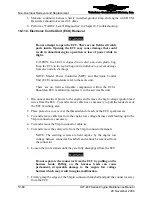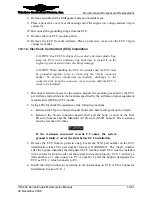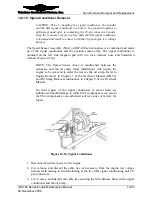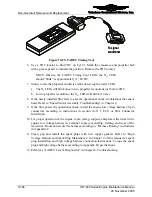
Teledyne Continental Motors, Inc.
TM
Non-Overhaul Removal and Replacement
IOF-240 Series Engine Maintenance Manual
10-51
31 August 2007
Change 1
Figure 10-36.
Completed EGT Sensor Lead Wire Splice
32.
Inspect the continuity of the sensor lead wires. If the inspection reveals poor
continuity readings and/or if any wire appears damaged, repair wire as described in
this section.
33.
If splice was for wire repair, proceed to step 34. If sensor was removed for
replacement, install the EGT sensor according to instructions in Section 10-11.19,
"Exhaust Gas Temperature Sensor Installation.”
34.
If all lead wiring is intact, bundle the sensor leads as required. For proper operation of
the engine, route, clamp, support, and protect the wires in the low voltage harness in a
manner to prevent chafing, fretting, and wear of the lead wires. Route and secure the
harness according to “Harness Routing” in Appendix C.
CAUTION: Avoid making sharp bends or kinks in the lead wires.
35.
Perform a FADEC Level I Diagnostic according to instructions in Chapter 8,
Troubleshooting.
10-10.3. Non-EGT Sensor and Lead Wire Replacement
Equipment Required:
•
Crimp tool
•
Non-EGT Sensor/Wire Splice Kit
•
Utility or razor knife
•
Scissors
•
A variable intensity heat gun with a small deflector tip
Prerequisites:
Before proceeding, review Sections 10-1, “Parts Replacement” and 10-10, “Engine Low
Voltage Harness Lead Wire Repair and Sensor Replacement.”
Procedure
1.
Turn the Aircraft Master Power Switch and FADEC Enable Switches to the OFF
position and disconnect engine electrical power.
CAUTION: Failure to use the correct splice kit will result in
abnormal engine operation and may cause engine damage.
2.
Inventory the Non-EGT Sensor/Wire Splice kit according to the parts list.
3.
Cut and remove all cable ties supporting the defective wire or sensor.
4.
Remove the faulty sensor or damaged wires.
5.
Cut the leads to be spliced two and a half inches longer than the replacement sensor
lead which will result in an acceptable 4-inch overlap.
















































